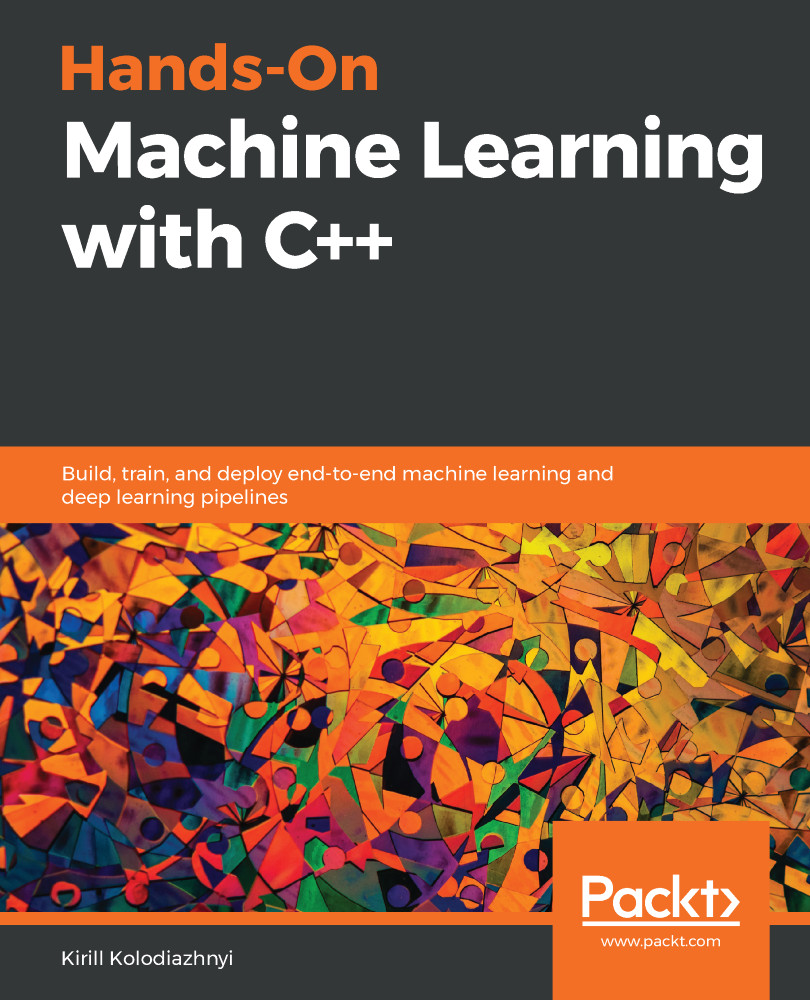Hands-On Machine Learning with C++'s example-based approach will show you how to implement supervised and unsupervised ML algorithms with the help of real-world examples. The book also gives you hands-on experience of tuning and optimizing a model for different use cases, helping you to measure performance and model selection. You'll then cover techniques such as object classification and clusterization, product recommendations, ensemble learning, and anomaly detection using modern C++ libraries such as the PyTorch C++ API, Caffe2, Shogun, Shark-ML, mlpack, and dlib. Moving ahead, the chapters will take you through neural networks and deep learning using examples such as image classification and sentiment analysis, which will help you solve a wide range of problems.
Later, you'll learn how to handle production and deployment challenges on mobile and cloud platforms, before discovering how to export and import models using the ONNX format. By the end of this book, you'll have learned how to leverage C++ to build powerful ML systems.
Chapter 1, Introduction to Machine Learning with C++, will guide you through the necessary fundamentals of ML, including linear algebra concepts, ML algorithm types, and their building blocks.
Chapter 2, Data Processing, will show you how to load data from different file formats for ML model training and how to initialize dataset objects in various C++ libraries.
Chapter 3, Measuring Performance and Selecting Models, will show you how to measure the performance of various types of ML models, how to select the best set of hyperparameters to achieve better model performance, and how to use the grid search method in various C++ libraries for model selection.
Chapter 4, Clustering, will discuss algorithms for grouping objects by their essential characteristics, show why we usually use unsupervised algorithms for solving such types of tasks, and lastly, will outline the various types of clustering algorithms, along with their implementations and usage in different C++ libraries.
Chapter 5, Anomaly Detection, will discuss the basics of anomaly and novelty detection tasks and guide you through the different types of anomaly detection algorithms, their implementation, and their usage in various C++ libraries.
Chapter 6, Dimensionality Reduction, will discuss various algorithms for dimensionality reduction that preserve the essential characteristics of data, along with their implementation and usage in various C++ libraries.
Chapter 7, Classification, will show you what a classification task is and how it differs from a clustering task. You will be guided through various classification algorithms, their implementation, and their usage in various C++ libraries.
Chapter 8, Recommender Systems, will give you familiarity with recommender system concepts. You will be shown the different approaches to deal with recommendation tasks, and you will see how to solve such types of tasks using the C++ language.
Chapter 9, Ensemble Learning, will discuss various methods of combining several ML models to get better accuracy and to deal with learning problems. You will encounter ensemble implementations with the usage of different C++ libraries.
Chapter 10, Neural Networks for Image Classification, will give you familiarity with the fundamentals of artificial neural networks. You will encounter the essential building blocks, the required math concepts, and learning algorithms. You will be guided through different C++ libraries that provide functionality for neural network implementations. Also, this chapter will show you the implementation of a deep convolutional network for image classification with the PyTorch library.
Chapter 11, Sentiment Analysis with Recurrent Neural Networks, will guide you through the fundamentals of recurrent neural networks. You will learn about the different types of network cells, the required math concepts, and the differences of this learning algorithm compared to feedforward networks. Also, in this chapter, we will develop a recurrent neural network for sentiment analysis with the PyTorch library.
Chapter 12, Exporting and Importing Models, will show you how to save and load model parameters and architectures using various C++ libraries. Also, you will see how to use the ONNX format to load and use a pre-trained model with the C++ API of the Caffe2 library.
Chapter 13, Deploying Models on Mobile and Cloud Platforms, will guide you through the development of applications for image classification using neural networks for the Android and Google Compute Engine platforms.












































































